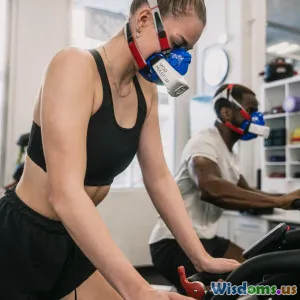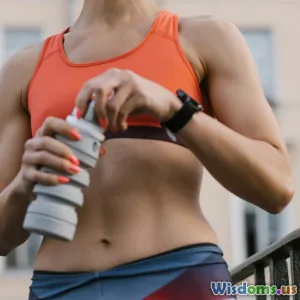
Breaking Down VO2 Max Why It Matters for Endurance Athletes
9 min read Discover the science of VO2 max and why it's crucial for boosting endurance sports performance. (0 Reviews)
Breaking Down VO2 Max: Why It Matters for Endurance Athletes
Endurance athletes—from marathon runners to professional cyclists—frequently seek ways to push their performance boundaries. Among numerous physiological markers, one stands out as a powerful predictor of aerobic capacity and endurance potential: VO2 max. But what exactly is VO2 max, why does it matter, and how can athletes leverage this metric to elevate their training and results? This article unpacks the science behind VO2 max, its practical significance in sports, and the strategies athletes can use to maximize their aerobic capacity.
What Is VO2 Max?
VO2 max, or maximal oxygen uptake, refers to the maximum volume of oxygen the body can use during intense exercise, measured in milliliters of oxygen consumed per kilogram of body weight per minute (ml/kg/min). It's essentially the gold standard measure for cardiorespiratory fitness and indicates how effectively the heart, lungs, and muscles utilize oxygen.
Dr. Bengt Saltin, a leading exercise physiologist, famously linked VO2 max to endurance performance, describing it as the "silver bullet" for aerobic fitness assessment. A higher VO2 max implies a greater potential for oxygen delivery to working muscles, enabling sustained high-intensity efforts.
How VO2 Max Works
When you work out, your muscles require oxygen to convert fuel (carbohydrates and fats) into energy. VO2 max reflects the ultimate ceiling of this process — the physiological cap on how much oxygen your body can absorb, transport, and use.
Factors influencing VO2 max include:
- Cardiac output: The amount of blood pumped by the heart per minute.
- Pulmonary function: Efficiency of the lungs in oxygen transfer.
- Muscle mitochondrial density: Where oxygen is used in energy production.
For example, elite cross-country skiers often have VO2 max values above 80 ml/kg/min, compared to average untrained individuals who range between 30-40 ml/kg/min.
Why VO2 Max Matters for Endurance Athletes
Endurance sports depend heavily on aerobic capacity, as races and events last from several minutes to hours. VO2 max provides a comprehensive measure of an athlete's aerobic engine size, directly correlating with endurance potential.
Performance Predictor
Research consistently shows a strong relationship between VO2 max and endurance event performance:
- A 2019 study published in Sports Medicine found that athletes with higher VO2 max consistently outperformed peers in events like marathons, triathlons, and long-distance cycling.
- The legendary cyclist Lance Armstrong had a recorded VO2 max of approximately 84 ml/kg/min during his career, one reason behind his unparalleled climbing capability.
However, VO2 max isn't the sole determinant. Factors like lactate threshold, running economy, and mental resilience also play crucial roles.
Personalized Training & Monitoring
Knowing an athlete’s VO2 max allows coaches to tailor training programs effectively. For instance:
- Training zones can be accurately set relative to VO2 max to optimize endurance and recovery.
- Monitoring VO2 max over time reveals if conditioning improves or plateaus, providing actionable feedback.
Health and Longevity
Beyond competition, higher VO2 max values associate with lower risks of cardiovascular disease and mortality.
An analysis in Circulation revealed that each 1 MET increase (MET = metabolic equivalent, 3.5 ml O2/kg/min) in VO2 max corresponds to about a 13% reduction in all-cause mortality risk.
Measuring VO2 Max: Laboratory and Field Methods
Laboratory Testing
The gold standard for VO2 max measurement involves a graded exercise test (GXT) using a metabolic cart:
- The athlete typically runs or cycles with increasing intensity.
- Exhaled gases are analyzed to quantify oxygen consumption.
This test provides highly accurate data but requires specialized equipment and trained personnel.
Field Tests
For many, practical options offer approximate VO2 max estimations:
- Cooper Test: Running as far as possible in 12 minutes. Distance covered converts into VO2 max estimates.
- Rockport Walk Test: Time taken to walk 1 mile, combined with heart rate, body weight, and age.
- Heart Rate Sensors & Wearables: Modern devices estimate VO2 max using algorithms from heart rate variability and pace data.
While easier to administer, these methods are less precise and influenced by external factors.
How to Improve VO2 Max
The exciting news for endurance athletes is that VO2 max is trainable, and many scientific studies provide proven strategies.
High-Intensity Interval Training (HIIT)
Research indicates that HIIT—short bursts of near-maximal effort followed by recovery—can significantly enhance VO2 max.
A 2017 meta-analysis in Journal of Sports Science & Medicine concluded that 2-3 weekly sessions of HIIT over 6-8 weeks yielded improvements up to 15%.
Example workout:
- 5 x 3 minutes at 90-95% maximum heart rate
- 3-minute active recovery between intervals
Endurance Base Training
Sustaining long-duration efforts at moderate intensity increases mitochondrial density and capillarization in muscles, both factors contributing to aerobic efficiency.
Elite athletes often perform 70-80% of training time at low intensities to build this foundation.
Strength and Cross-Training
Incorporating strength training supports muscular endurance and improves running economy, indirectly aiding VO2 max gains.
Additionally, cross-training reduces injury risk and promotes cardiovascular adaptations without excessive joint stress.
Nutrition and Recovery
Adequate fueling with carbohydrates and protein alongside quality sleep is vital to enable physiological adaptations that enhance VO2 max.
Limitations and Considerations
VO2 max is a valuable metric but should be interpreted as part of a holistic performance analysis:
- Genetics play a significant role: Studies suggest 40-50% of VO2 max variation may be hereditary.
- VO2 max plateaus with training; beyond this point, other factors determine performance.
- Psychological factors, pacing strategy, and technique profoundly affect race outcomes.
Therefore, VO2 max is a tool—not the sole predictor—of success.
Conclusion
For endurance athletes, VO2 max unlocks a window into aerobic capacity, serving as a cornerstone metric to guide training and track progress. Its direct link to oxygen uptake efficiency makes it indispensable for understanding physical limits and maximizing potential.
By combining precise measurement, targeted training interventions like HIIT, proper recovery, and nutrition, athletes can work towards elevating their VO2 max—and by extension, their endurance performance. However, it remains critical to consider VO2 max within the broader context of overall fitness, technique, and mental fortitude.
Whether you are a weekend warrior chasing marathon PRs or an elite cyclist strategizing your next season, understanding and harnessing VO2 max empowers smarter, science-backed preparation. Armed with this knowledge, the path toward peak endurance performance comes into clearer focus.
References:
- Bassett, D. R., & Howley, E. T. (2000). Limiting factors for maximum oxygen uptake and determinants of endurance performance. Medicine and Science in Sports and Exercise, 32(1), 70-84.
- Laursen, P. B., & Jenkins, D. G. (2002). The scientific basis for high-intensity interval training. Sports Medicine, 32(1), 53-73.
- Kodama, S., Saito, K., Tanaka, S., et al. (2009). Cardiorespiratory fitness as a quantitative predictor of all-cause mortality and cardiovascular events. JAMA, 301(19), 2024-2035.
- Joyner, M. J., & Coyle, E. F. (2008). Endurance exercise performance: the physiology of champions. Journal of Physiology, 586(1), 35-44.
Rate the Post
User Reviews
Other posts in Exercise Physiology
Popular Posts














